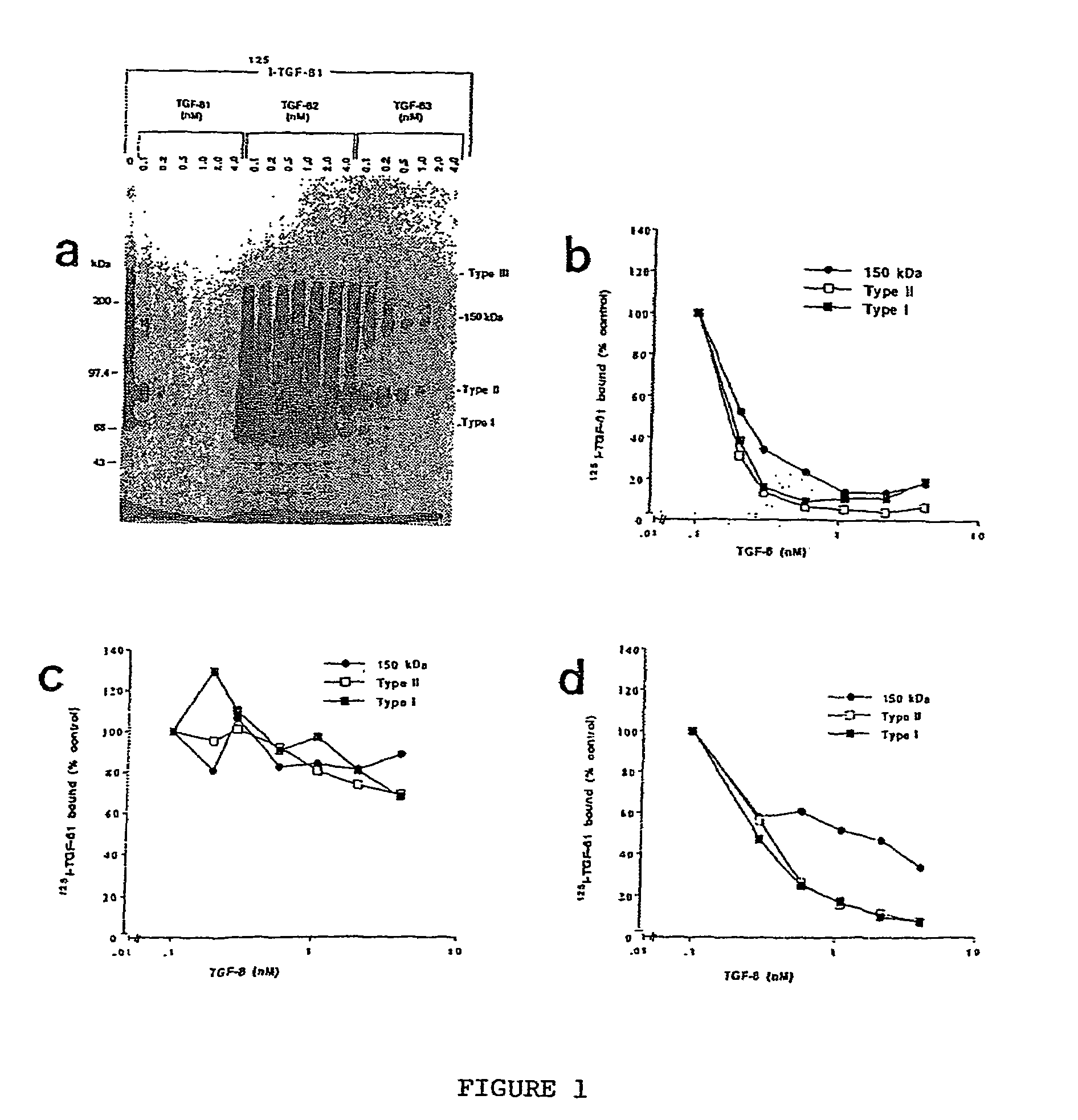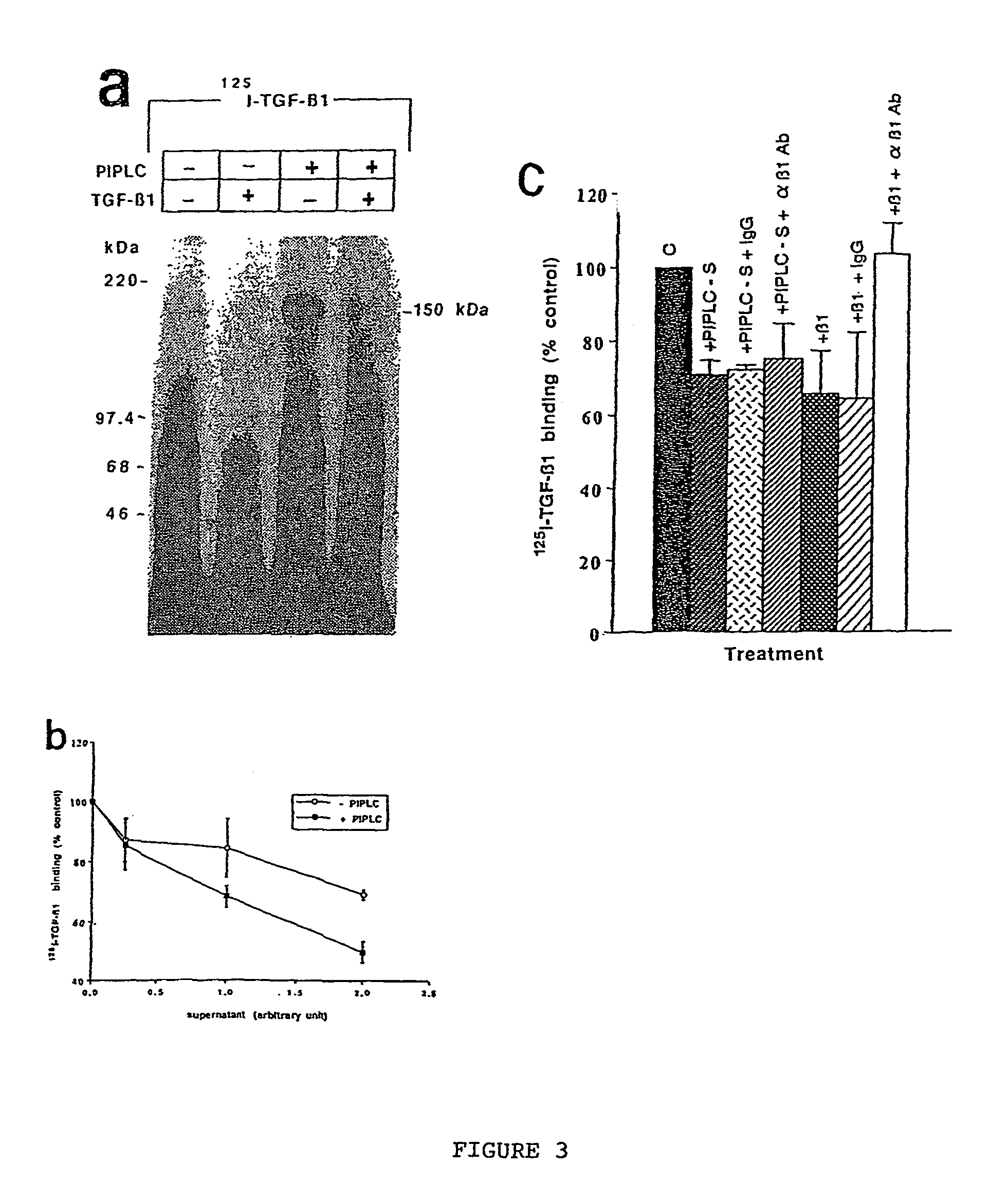150 KDA TGF-B1 accessory receptor acts a negative modulator of TGF-B signaling
a technology of tgf-b signaling and accessory receptor, which is applied in the direction of receptors for growth factors/regulators, peptide sources, botany apparatus and processes, etc., can solve the problems of difficult interpretation of obtained results and unexplained functional significance of this phenomenon, and achieve tissue protective effects
- Summary
- Abstract
- Description
- Claims
- Application Information
AI Technical Summary
Benefits of technology
Problems solved by technology
Method used
Image
Examples
example 1
Characterization of TGF-β1 Binding Protien Different from other TGF-β Receptors
Methods
Cell Culture:
[0093]Neonatal keratinocytes were prepared from foreskin tissue obtained at newborn male circumcision as described by Germain et al (1993). The keratinocytes were cultured in keratinocyte serum free medium (Gibco, Burlington, Ontario) and cells of third to fifth passage were used for experiments. The immortalized keratinocyte cell line, HaCaT, was obtained from Dr. Boukamp (Heidelberg, Germany), and the mink lung epithelial cells (Mv1Lu) were from ATCC. Both cell types were maintained in Dulbecco's Minimal Essential Medium (D-MEM) supplemented with 5% FBS, 1 mM sodium pyruvate, 2 mM glutamine, 100 U / ml penicillin, 100 μg / ml streptomycin, and 0.25 μg / ml amphotericin (Gibco, Burlington, Ontario). All cells were maintained at 37° C. in an atmosphere of 5% CO2 / air.
Affinity Labeling of Cells:
[0094]Iodination of TGF-β1 (Collaborative Biomedical) was done as described (Philip and O'Connor-McC...
example 2
Creation of Keratynocyte Cell Line Mutants Deficient in GPI Anchor Biosynthesis
Materials and Methods
[0126]Cell Culture: An immortalized human keratinocyte cell line, HaCat, was obtained from Dr. P. Boukamp (Hedielberg, Germany). HaCat is a spontaneously immortalized cell line which displays no major differences in differentiation as compared to normal keratinocytes. It possesses a transformed phenotype, but is not tumourigenic (Boukamp et al, 1988). HaCat cells were cultured in D-MEM containing 10% fetal bovine serum, 1 mM sodium pyruvate, 2 mM glutamine and 100 U / ml penicillin, 100 μg / ml streptomycin, and 0.25 μg / ml amphotericin (all Gibco, Burlington, Ontario).
[0127]Doubling Time: 8×105 Cells were Seeded at in 60 mm Dishes (Falcon) in Duplicate. At Indicated Times, Cells were Trypsinized and Counted Using a Hemocytometer
[0128]Affinity labeling of cells: Affinity cross-link labeling techniques were performed as detailed by Dumont et al (1995). Briefly, monolayers of cells were wash...
example 3
Sequence of r150 and Nucleic Acids Encoding the Same
[0152]Cloning of r150 and expression of r150 gene confirm that r150 is an inhibitor of TGF-responses: To determine its structural identity, r150 was purified on a TGF-1 affinity column and analyzed by tandem mass spectrometry (Harvard Microchemistry Facility, Harvard Univ) which allowed us to obtain a 19 amino acid microsequence. This matched to the 5′ end of an express sequence tagged (EST) cDNA clone of unknown function from human placenta. Subsequently, sequencing by PCR using seven primers, the full sequence was obtained. Alignment and conserved domain analysis revealed it to be a novel protein of 1428 amino acids with an N-terminal signal sequence and a C-terminal GPI anchor attachment signal sequence (FIG. 12 and SEQ ID No: 2). The most likely GPI anchor cleavage site (ω) is at amino acid residue 1404. The predicted molecular mass and structural features indicate that this gene product represents r150. This novel TGF-accessor...
PUM
| Property | Measurement | Unit |
|---|---|---|
| molecular weight | aaaaa | aaaaa |
| temperature | aaaaa | aaaaa |
| pH | aaaaa | aaaaa |
Abstract
Description
Claims
Application Information
 Login to View More
Login to View More - R&D
- Intellectual Property
- Life Sciences
- Materials
- Tech Scout
- Unparalleled Data Quality
- Higher Quality Content
- 60% Fewer Hallucinations
Browse by: Latest US Patents, China's latest patents, Technical Efficacy Thesaurus, Application Domain, Technology Topic, Popular Technical Reports.
© 2025 PatSnap. All rights reserved.Legal|Privacy policy|Modern Slavery Act Transparency Statement|Sitemap|About US| Contact US: help@patsnap.com



